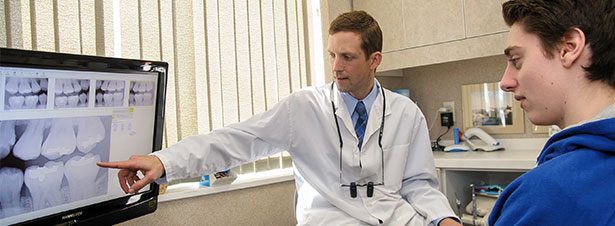
Trust is a defining element in any relationship. When it comes to the patient-dentist relationship, case acceptance depends heavily on a patient’s trust in his or her dentist.
Dr. Michael Skramstad, DDS, builds trust with his patients by using digital radiography. The advanced technology and imaging builds greater patient confidence in his diagnoses, and case acceptance at his Minnesota practice, Orono Dental Care, is at an all-time high.
Improving the Patient Experience
Dr. Skramstad incorporates a number of Sirona technologies at his practice, including CEREC, Orthophos XG 3D, and the Schick 33 digital intraoral sensor. He utilizes all three Schick 33 sensor sizes (0, 1 and 2) to accommodate patients of all ages.
Dr. Skramstad evaluates the images and enlarges them individually on his computer monitor to get a closer look. Thanks to the high resolution imaging of the Schick 33 sensor, he doesn’t need to worry about gradation issues; any dental abnormalities or lesions that exist show up vividly on the monitor. He highlights areas of concerns using the image enhancer tool and discusses the findings with his patients one-on-one.
“Whether I’m discussing the appearance of a filling or the whereabouts of a cavity, the digital images help to generate discussions with my patients about their oral health. It’s important that they understand the purpose of dental X-ray. Walking them through the diagnosis helps with comprehension,” said Dr. Skamstad. “These discussions are key to enhancing the patient-dentist relationship and build the trust factor.”
Gaining Understanding
Dr. Skramstad catches dental problems earlier using the Schick 33 sensor and that often leads to conservative treatment plans, which his patients are more likely to accept.
“If a child has a toothache, parents can see right away where the problem is. The Schick 33 images are so clear that there really are no questions about the diagnosis. It’s easy for parents to see why we need to handle things right away rather than delay treatment,” he said.
Dr. Skramstad feels digital radiography overall improves the lines of communication between him and his patients. Patients want to hear how you came to a diagnosis and treatment plan; that can be difficult to explain when you have to rely on a small film X-ray. That’s where the real value of digital radiography comes in.
“If your patient, or the patient’s parent, doesn’t have trust in your reading of the X-ray, case acceptance and behavior change will be difficult,” said Dr. Skamstad. “Digital radiography eliminates the doubt.”
Share with your colleagues